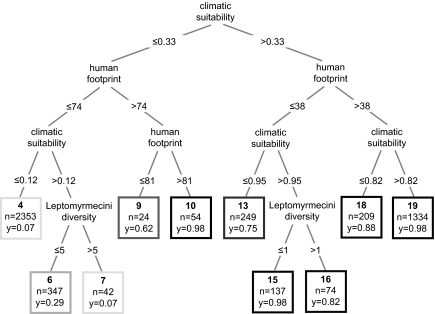Fig. 2.
Classification tree used to identify the roles of abiotic, biotic, and human-mediated factors in explaining the worldwide distribution of the Argentine ant. Only the most influential variables were used to construct the tree: climatic suitability (ranging from 0 to 1, with higher values corresponding to areas with higher climatic suitability), degree of human modification of habitats (ranging from 0 to 100, with higher values corresponding to highly disturbed areas), and ant generic diversity of the Leptomyrmecini tribe at the country level (with a maximum number of nine genera) (Table 1). The length of the tree was limited to a maximum of four node levels, and the variables and conditions (i.e., threshold value) used to split the records are indicated at each split. For example, the terminal node 10 corresponds to localities with a climatic suitability ≤0.33 and a degree of human modification of the habitat >81. n values indicate the total number of observations assigned to the terminal nodes, and y values show the proportion of presences. Boxes with darker grays correspond to higher y values at the terminal node.

